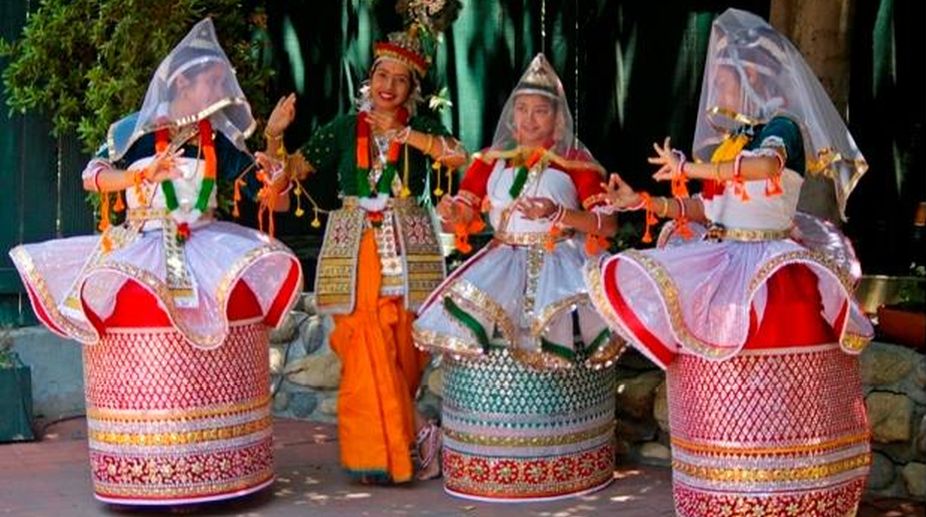Man sets himself on fire in New York outside Trump’s criminal trial court
The man threw pamphlets into the air and poured accelerant on himself, according to the reports.

(Photo: Facebook)
It was this reviewer’s good fortune to watch A Silent Journey of Rhythm, a documentary film on Manipuri nritya Guru Debjani Chaliha by Indrajit Narayan at ICCR, Kolkata, recently. As a dance historian and reviewer, I have been closely following Chaliha and the film gave me a full picture of the life and times of this great artist, scholar, writer, academician, teacher and social worker.
Possessed with qualities of both head and heart, Minakshi or Debjani has always kept a low profile, though her working life has been inexhaustible. Being the youngest in an aristocratic family, she was nicknamed Ijoni. She was named Minakshi after one of the two girls who accompanied Mahatma Gandhi.
The great soul had actually visited the Chaliha house at Sivsagar just before her birth on 10 May 1934 when he had gone there to propagate ideas for opium eradication. Minakshi’s father was an industrialist who set up tea gardens and most importantly established the famous Chaliha Rolling Mills in Tollygunge, Kolkata.
Advertisement
From the documentary, one came to know that after a stint in Rabindranath Tagore’s school, Patha Bhavan in Santiniketan, Minakshi passed her Matriculation from St John’s Diocesan School, Calcutta, learning music and dance at Bani Bidyabithi at the same time. While studying in Ashutosh College, she enrolled under Brajabasi Singha to learn Manipuri while simultaneously making a foray into writing with a book in Assamese called Jontu Janwar, published in 1951 from Sreebhumi Publications.
At Ashutosh College, she found her life-long partner in Biswapriya Basu whom she married in 1960. After finishing her Intermediate with a first class first, she joined Presidency College to get a Bachelor’s degree but fate had something else in store as she completed her graduation from Lady Kean’s College in Shillong.
Back in Kolkata, while pursuing her Master’s in philosophy from Calcutta University, she was selected to perform Manipuri dance at the Inter-University Festival in New Delhi in 1955. When she saw a performer from Guwahati University perform Manipuri, realisation dawned that her brand of the dance form was not perfect —right then she resolved to rectify it.
Her neighbour at Golf Club Road, Nrityaguru Udayshankar was then the dean of dance at The Academy of Dance, Drama and Music, by which name Rabindra Bharati University was known, where Minakshi had joined to pursue dance. He advised her to learn Manipuri from Guru Maisnam Amubi Singh at Imphal.
Her dance and academics ran parallel to each other. Soon after her Master’s, she was appointed lecturer in philosophy at Dhanamanjari College, Imphal. The big chance came to her and she became a resident student in her guru’s house, learning dance and teaching philosophy to students at the same time.
In 1971, after settling down in Kolkata, she started her dance institution Meitei Jagoi at the location of Sarbahara Sishutirtha run by Rekha Basu. When she was launched as a professional performer at Kalamandir on 29 September 1970 by celebrated actor, Kulada Kumar Bhattacharjee, her name was changed to Debjani Chaliha.
The show was a huge success. Chaliha’s aesthetic pursuits have been etched meticulously in the documentary.
Her recognition as a Manipuri dancer of the Guru Maisnam Amubi Singh style, came from Central Sangeet Natak Akademi, when she was awarded the “Tagore Samman” during the poet’s 150th birth anniversary. Deeply connected with Jawaharlal Nehru Manipuri Dance Academy at Imphal, she had been assigned to write the biography of her guru —Manipuri exponent and the founding supervisor of JNMDA — Maisnam Amubi Singh during the academy’s diamond jubilee year, which has been published by the Sangeet Natak Akademi. She has the honour of being the external examiner of Manipuri dance at Viswa Bharati University and a member of their board of studies. Presently she is in the process of translating Lalon Fakir’s verses into Assamese. Professor Abul Ahsan Chowdhury of the department of Bengali, Islamia University, Kustia, Bangladesh has written a biography on her. Chaliha has defied age. At 84, she starts her day with a yoga session at 5.30 am.
She has her dance, music practice, teaching sessions and also attends the family office, Chaliha Corporates. Her evenings are reserved for dance and music performances, which she attends as chief guest or simply as a rasika. Indrajit Narayan has not only directed the documentary but is also responsible for the extensive research on her and writing the screenplay.
The film is especially alluring for capturing the scenic beauty of Assam and Manipur to tell the story of Debjani, who belongs to Assam, Manipur and West Bengal. If assessed from a professional point of view, the documentary is worth an award. To trace the life of a person born in the 1930s when technology was not as developed must have been a herculean task.
The cinematography was excellent and there wasn’t a single moment of sagging interest in the more than hour-long documentary. Without the help and cooperation of people like Swapan Kumar Dutta, vicechancellor of Visva Bharati University; L Upendra Sharma, director, Jawaharlal Nehru Manipuri Dance Academy Imphal, West Bengal Dance Group Federation, Doordarshan Kendra, Kolkata, among others, the film wouldn’t have been possible.
A Silent Journey of Rhythm has been dedicated to Manipuri nritya Guru Maisnam Amubi Singh and French Impressionist painter, Edgar Degas.
Advertisement